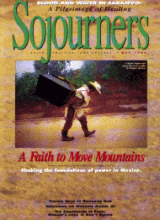The remaining gospels of eastertide play out Jesus farewell discourse in the latter chapters of John. In the synoptics, conversation at the Last Supper is spare and concise, while hereas if to a community clinging on every word and hungry for moreit turns in slow concentric spirals, parceling out love and encouragement. This "community of the beloved disciple" is under persecution of one sort or another. They have publicly declared themselves and now pull together in a tightening circle.
Meanwhile, a parallel set of readings for this series is from Acts, which originates in a community clearly of a more expansive mode, breaking down barriers within and without. The juxtaposition of the two sets up, as lectionaries always do, a conversation between one another. And between the two the Spirit may be heard, a holy Spirit who seems to be working freely both sides of the aisle.
It is for us, firstly, to sit back and listen. And then to enter the conversation.
May 1
Roots of Nonviolence
Acts 8:26-40;Psalm 22:25-31;1 John 4:7-12;John 15:7-12
On the one hand, its no surprise in Acts: A high government official is intrigued and perplexed by a classic biblical text of nonviolence. And yet his questions are lucid ones (indeed the scholars still ask them of the servant songs in Isaiah): Of whom does the passage speak? The prophet? Someone else, perhaps a messianic figure? Or is this a more collective image, of a remnant or even Israel as a whole?
Philip seizes the question as an opening. He begins where the Ethiopian official is. He tells the story of Jesus as though its form and outline were there to be seen on the page with the suffering servant, or as though gospel nonviolence and the way of the cross could trace it roots to this very text.
Read the Full Article
